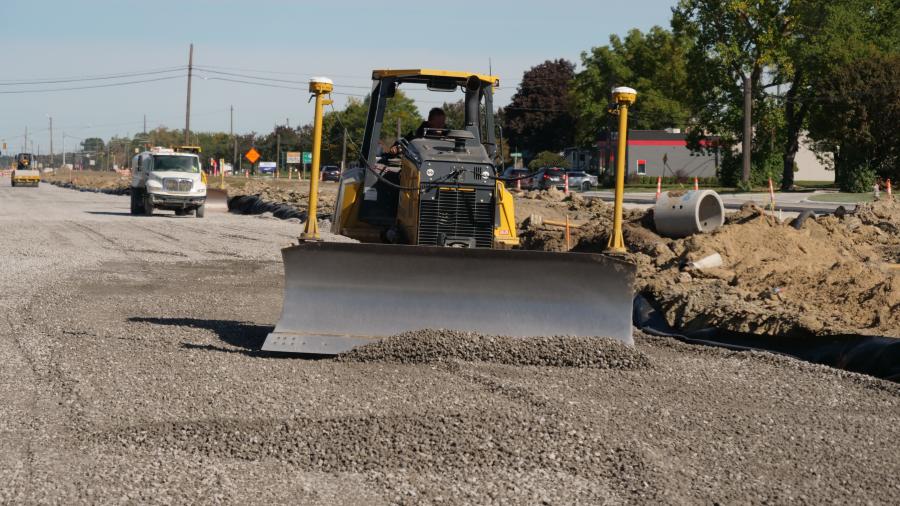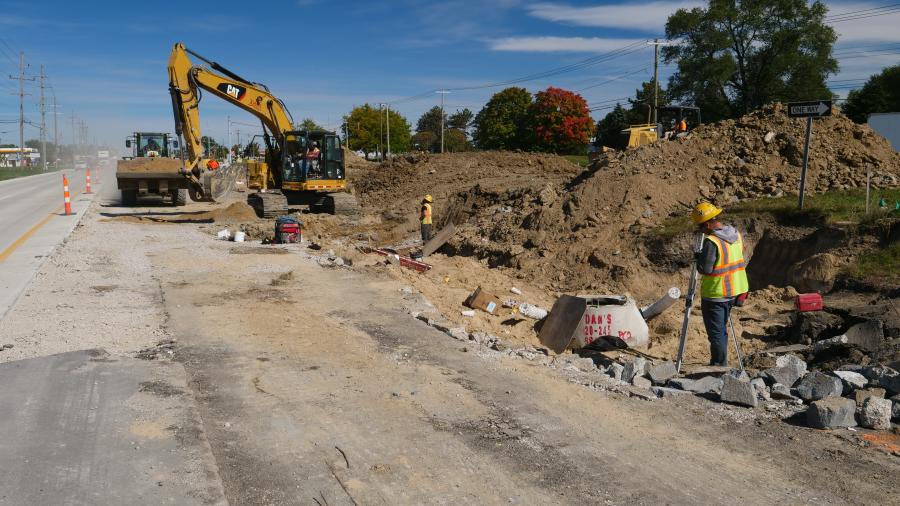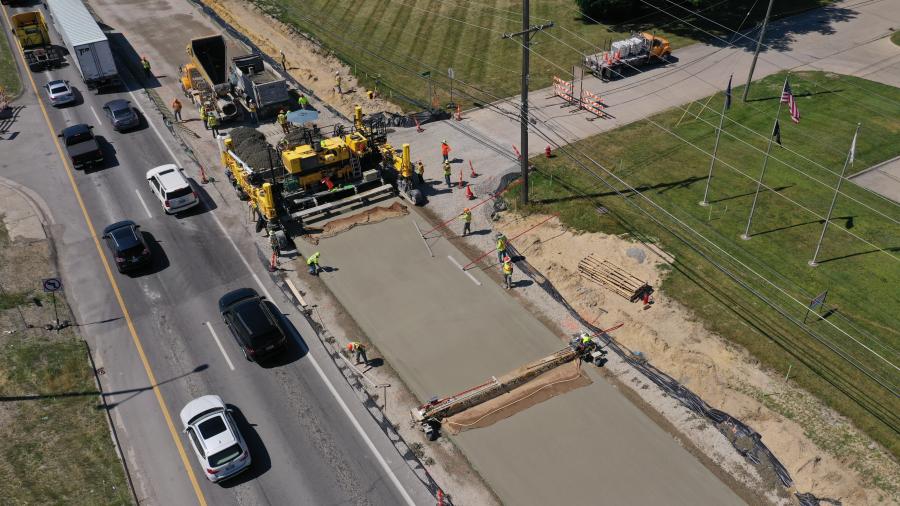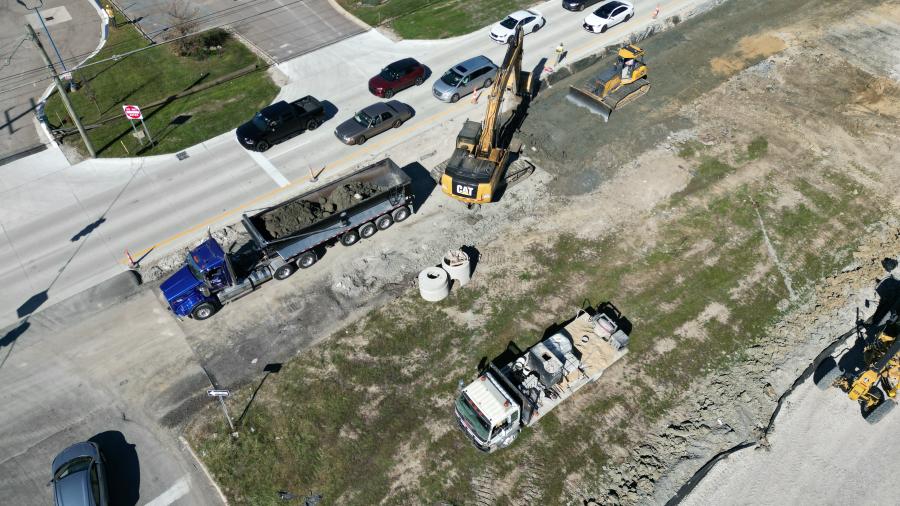Site work has been busy, with contractors performing various tasks from I-696 to M-59.
(First Media Group photo)
In an effort to rebuild one of the most significant corridors in southeast Michigan, construction crews are immersing themselves in the Innovate Mound project. The multi-million-dollar undertaking will reportedly strengthen connectivity by using sophisticated design and smart technology to build a modern, multimodal stretch of roadway.
"Aside from the economic importance, the corridor serves as a main connector between I-696 and M-59 while connecting neighborhoods from Sterling Heights to Warren," said Steve Griffith, construction department manager of the civil engineering and infrastructure firm HNTB. "It's of the utmost importance that the Mound Road corridor stays in good condition to ensure economic and social benefits can continue to grow.
"For years, Mound Road has been notorious for its potholes and constant rehabilitation projects that have been plaguing one of the country's most economically important corridors. Macomb County was spending a significant portion of its annual maintenance budget on Mound Road alone. The county could not afford the costs to completely reconstruct the corridor and looked for potential funding support."
Macomb County is leading the Innovate Mound project, working closely with the city of Sterling Heights, the city of Warren and the Michigan Department of Transportation (MDOT). County officials hired HNTB to perform program management, construction engineering and inspection.
The overall Innovate Mound program cost is approximately $250 million. In 2017, Macomb County applied for a federal INFRA grant to pay for reconstruction. A total of $98 million in federal funds was awarded to the county from the USDOT. The grant required that all funds be spent, and the project be completed by the end of 2024.
Griffith noted that the time had come to carry out the work.
"Mound Road, though still functional and drivable, needed a total reconstruction. In previous years, Macomb County made it a priority to continuously rehabilitate the pavement to ensure it continued to be serviceable. After performing a life cycle analysis on the corridor, Macomb County determined it was the optimal time to reconstruct it, to avoid additional wasted costs on any more rehab."
Griffith said to effectively reconstruct Mound Road, traffic was reduced to two lanes in each direction. Major intersections are permitted to be closed for 21 days to expedite the construction at these roads and minimize lane closures.
Additional lane closures are permitted during nighttime hours to minimize impacts to traffic, while also allowing sufficient room for the design-builder to safely complete construction activities.
Griffith pointed out the importance of receiving feedback.
"Community input is paramount to the success of the project. The team has conducted five different open house events throughout the life of the project to receive feedback to implement in the design and provide an update on the construction status.
In addition, the project team has conducted more than 100 meetings with various businesses and community groups to inform stakeholders of the project status during both the design and construction phases."
To date, construction has been progressing well with minimal delays and conflicts. Construction is currently 45 percent complete.
"Like any other project, the construction team has experienced some unexpected issues dealing with unknown utilities and right-of-way restrictions, especially in the limits where we are expanding from three to four lanes," said Griffith.
According to Ryan Sarmiento, HNTB engineering construction services, some of the biggest challenges have involved utility relocations.
"With the changes being made by widening Mound Road from 17 Mile Road to M-59, installing an 8-ft. wide non-motorized path on the west side of Mound Road from 14 Mile Road to M-59 and installing median basins, utility relocations are a major task and challenge to coordinate the more than 10 utility companies that need to relocate. Getting everyone to the table to understand the needed relocations and the order of utilities that need to be relocated from first to last is every project's largest challenge."
Access management also must be addressed.
"We understand businesses and residents must be able to operate as normal regardless of the construction impacts. It's a challenge to ensure there are minimal impacts to these stakeholders during construction. This includes reaching out to these individuals to inform them of the work that will be occurring in front of their property, so they can properly prepare for any impacts.
"Another challenge is reconstructing their driveways without cutting access to their property off entirely. This is achieved by part-width construction."
Sarmiento said rebuilding Mound Road in Macomb County from I-696 north to M-59 is no small task.
"This is a total reconstruction, which includes pavement removal, storm sewer, watermain and sanitary improvements, as well as cutting and building grade, paving concrete, paving curb and sidewalk, installation of traffic signals, permanent signs, pavement markings, restoration, bridge widening, box culvert replacement, structure rehabilitation and much more."
For the majority of the corridor, there will be continuous sidewalk on both the east and west side of the road. On the west side, a non-motorized path will be installed from 14 Mile Road to M-59, which will accommodate cyclists, runners and walkers.
Sarmiento said the north segment (15 ½ Mile Road to M-59) outside two lanes are complete.
"Crews are working on the inside two lanes, including crossovers. North segment watermain, sanitary and storm sewer improvements are close to completion. The contractor began working on the south segment I-696 to 15 ½ Mile Road to install temporary widening within the median lanes of northbound and southbound Mound, including storm sewer and watermain improvements."
Among the tasks remaining are crossover reconstruction; traffic signal infrastructure; ITS infrastructure; permanent pavement markings; permanent traffic signs; restoration; and miscellaneous sidewalk on the north segment.
Sarmiento said the most time-consuming task for crews involves paving concrete.
"This is due to the extensive material and labor that go into the operation. Once the concrete is paved out, it takes roughly an additional five days to achieve the required strength prior to opening it up to traffic."
Site work has been busy, with contractors performing various tasks from I-696 to M-59.
The existing pavement and underlying base material was cut down 27 in. below the proposed top of pavement grade to construct the new pavement section. If underlying soil conditions were poor, this material was undercut and replaced with stone. The cross section of the proposed Mound Road pavement consists of 16 in. of open graded drainage course with 11 in. of concrete.
Demo was required for all existing pavement and infrastructure that is to be replaced or improved, including existing storm sewer, traffic signal/ITS conduit, etc. Additionally, portions of the Mound Road bridges over the Plum Brook Creek were torn down for widening of the bridges to accommodate the fourth lane.
Heavy machinery being used on the project includes bulldozers, excavators, rollers, dump trucks, a trimming machine, concrete paving machine, backhoes and survey equipment. Materials include aggregate stone, geotextile liner, underdrain pipe, storm sewer pipe, storm sewer manholes, water main pipe, concrete, reinforcement steel, topsoil, seed, mast arms and traffic signals.
Sarmiento said it's truly rewarding to work on a project that will serve so many for years to come.
"It means a lot. It's always great to see a project through its entire life cycle, from concept to construction. Once motorists and pedestrians are able to drive and enjoy the finished corridor, I am hopeful their everyday commute or trip will be more enjoyable." CEG
Today's top stories



















